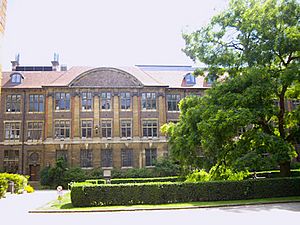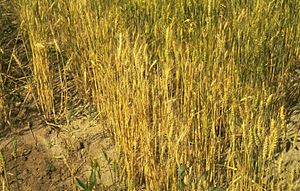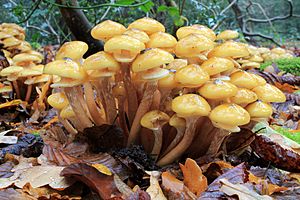Denis Garrett facts for kids
Stephen Denis Garrett (born November 1, 1906 – died December 26, 1989) was a British scientist who studied plants and fungi. He was a pioneer in understanding diseases that affect plant roots, especially those caused by tiny fungi living in the soil. He was the first to use ideas about ecology (how living things interact with their environment) to explain what happens underground. Much of his research focused on a fungus called Gaeumannomyces graminis, which causes a serious disease in cereal crops called take-all. He also studied Armillaria root rot, which affects trees.
Garrett spent most of his career at Rothamsted Experimental Station (1936–1948) and the University of Cambridge's plant sciences department (1949–1973). At Cambridge, he became a professor of mycology (the study of fungi) and even led the department for a while. He was also a fellow at Magdalene College, Cambridge. He led the British Mycological Society and helped create the British Society for Plant Pathology. He wrote four important books, with Root Disease Fungi (1944) and Biology of Root-infecting Fungi (1956) being the most well-known. He also edited science journals like Annals of Applied Biology.
Contents
Early Life and Learning

Denis Garrett was born in 1906 in a town called Leiston in Suffolk, England. His mother, Mary, came from a family that made tools. His father, Stephen, was a director in his family's farm machinery business. Denis was the oldest of four children.
When he was only eight years old, his father was killed in a battle during the First World War. After this, his mother moved the family to Oxford, and then later to Eastbourne. Garrett went to the Dragon School in Oxford. He briefly attended Wellington College, Berkshire, but he ran away from there! He then went to Eastbourne College, where he became very interested in plant biology and mathematics, even though there weren't many biology classes.
In 1926, he started studying natural sciences at Magdalene College, Cambridge at the University of Cambridge. He studied botany (the study of plants), chemistry, and geology. He learned from famous botanists and was especially inspired by an ecologist named Harry Godwin.
His Work as a Scientist
Garrett's career began in 1929 when he became an assistant plant pathologist in Adelaide, Australia. He researched two fungal diseases that affected cereal crops: take-all and "no-growth" diseases. He published his first research paper in 1932.
When he returned to the UK in 1934, he received a special scholarship. This allowed him to do research at Imperial College London. Here, he worked with a plant pathologist named William Brown, who taught him a lot about how to do scientific investigations.
In 1936, Garrett moved to the plant pathology department at Rothamsted Experimental Station. He stayed there for twelve years, even working through the Second World War. In 1947, the University of Cambridge gave him a special degree (Sc.D.) for his important work at Rothamsted.
In 1949, Garrett became a lecturer in mycology (the study of fungi) at the University of Cambridge. He stayed there for the rest of his career. He became a professor in 1971 and led the mycology department. He also became a fellow at Magdalene College in 1962. He retired in 1973 but continued to do experiments at home and publish his findings until 1984.
He also edited two important science journals, Annals of Applied Biology and Transactions of the British Mycological Society, from 1956 to 1962. He was the president of the British Mycological Society and helped create the British Society for Plant Pathology in 1966.
His Research and Books
Garrett's research mainly focused on diseases that affect plant roots, especially those caused by fungi in the soil. He wanted to understand how these diseases worked naturally so that farmers could prevent or control them. He is known as "the founding father of root pathology."
He understood that root diseases are complicated. He liked to do simple experiments, often using basic equipment like jam jars instead of expensive lab tools. He also studied how disease-causing fungi survived and lived in the soil, not just when they were attacking plants.
A lot of his work was on Gaeumannomyces graminis, the fungus that causes take-all disease in wheat. His early studies showed how soil conditions affect this fungus. He found that the amount of bacteria in the soil could influence how much the fungus infected plants. This was an early example of how different living things in the soil can compete with each other. He also discovered that the fungus couldn't spread easily through the soil; it needed to touch a plant root directly. He found that the fungus could survive in the soil by using cellulose (a material found in plant stubble) as food if there was enough nitrogen.
From 1950 to 1960, Garrett mainly studied Armillaria mellea, a fungus that causes Armillaria root rot in trees. He looked into ways to prevent this disease, for example, by treating the soil with chemicals. He also researched other plant diseases, like violet root rot in sugar beets and clubroot in brassicas.
Garrett's research helped us understand soil ecology, which is the study of how living things interact in the soil. He was one of the first to apply ideas from general ecology, like how communities change over time, to the hidden world of plant roots, soil fungi, and other tiny living things underground. One of his students said he made "the cold, dark, wet world below" feel real. He also created important ways to classify soil fungi based on how they lived in the soil.
He was known for being able to take very complex ideas and make them simple enough to test with experiments.
His Books
Garrett was a talented writer. His first book, Root Disease Fungi (1944), brought together all the known research on root-infecting diseases. It was praised for being clear and useful. Many scientists say this book encouraged a lot of new research on root diseases around the world.
His later books, Biology of Root-infecting Fungi (1956) and Pathogenic Root-infecting Fungi (1970), shared his own ideas and more recent research. These books were very influential and inspired many other scientists. His book Soil Fungi and Soil Fertility (1963) was a textbook for university students.
His Personal Life
In 1934, Garrett married Jane Perkins, whom he met on a boat trip. Jane became a psychiatric social worker and later wrote non-fiction books. They had three daughters.
Garrett loved natural history, especially birds. After moving to Cambridge, he became a keen plant observer, keeping careful records of all the plant species he saw locally and in Europe.
In 1964, he was diagnosed with coeliac disease and diabetes. In his later years, he started to lose his eyesight and had problems with his nerves due to diabetes. He passed away on December 26, 1989, in Cambridge.
Awards and Special Honours
Stephen Denis Garrett received many awards and honours for his important work:
- He was elected a fellow of the Royal Society in 1967, which is a very high honour for scientists in the UK.
- He also became a fellow of the Indian Academy of Sciences in 1973.
- He was an honorary fellow of the British Mycological Society and one of the first honorary fellows of the British Society for Plant Pathology.
- A special issue of the journal Plant Pathology was dedicated to him when he turned eighty.
- After he died, the British Society for Plant Pathology started an annual lecture in his memory.
Selected Books
- S. D. Garrett. Pathogenic Root-infecting Fungi (Cambridge University Press; 1970)
- S. D. Garrett. Soil Fungi and Soil Fertility (Pergamon Press; 1963, 1981)
- S. D. Garrett. Biology of Root-infecting Fungi (Cambridge University Press; 1956)
- S. D. Garrett. Root Disease Fungi (Chronica Botanica/Wm. Dawson and Sons; 1944)





